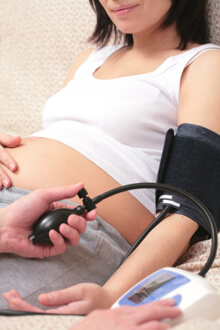Preeclampsia is a potentially deadly condition experienced during pregnancy, usually occurring after the 20th week of pregnancy, in either the late 2nd or 3rd trimesters. It is most simply defined as a condition where a pregnant woman develops protein in their urine, due to organ damage (most often the kidneys) and high blood pressure during late pregnancy. Thankfully, the condition isn’t too common, as it presently effects anywhere from 3 to 7% of all pregnancies, according to the U.S. National Library of Medicine.
Preeclampsia Signs
 Women who have preeclampsia sometimes do not realize they are sick, as they don’t feel all that bad. Some of the symptoms of mild preeclampsia include,
Women who have preeclampsia sometimes do not realize they are sick, as they don’t feel all that bad. Some of the symptoms of mild preeclampsia include,
- Sudden weight gain of over the course of one to two days of more than 2 lbs.
- Swelling of the eyes, known as edema, face and the hands.
Symptoms associated with a more severe form of preeclampsia can include the following:
- Trouble breathing.
- Not urinating often, decrease in urine output.
- Headache that won’t go away.
- Vomiting and nausea.
- Pain in the belly region, below the ribs, on the right side. It is also sometimes felt in the right shoulder. This symptom is often mistaken for other conditions or happenings, like kicking by the baby, a stomach virus, gallbladder pain or heartburn.
- Changes in vision, often including blurry vision, a sensitivity to light, seeing spots or flashing lights and even temporary blindness.
- Dizziness.
Causes of Preeclampsia
Preeclampsia’s exact cause is presently unknown. However, the following factors are thought to increase the likelihood of a woman developing the condition:
- Genetically predisposed or having a family history of the disease, or a previous pregnancy that involved preeclampsia.
- Being obese.
- Having a multiple pregnancy, which of course means having more than one baby at a time, such as having twins.
- Being a first pregnancy.
- The woman being older than 35 years of age.
- Having a history of kidney disease, high blood pressure or diabetes.
- A person’s diet.
- Issues with blood vessels.
- The presence of autoimmune disorders.
Diagnosing Preeclampsia:
During pregnancy, a woman’s doctor should always be on the lookout for the physical symptoms of preeclampsia listed above, such as weight gain, swelling and high blood pressure. In addition, if a doctor suspects a problem, they should order blood tests as a way to measure the protein in a woman’s urine, and to discover a low platelet count or high liver enzymes. When preeclampsia is discovered, doctors will do an ultrasound, non-stress test and other tests to decide if the baby should be delivered right away. Obviously, the more severe the condition, the more likely it is for a doctor to suggest delivery.
Preeclampsia Treatments:
Preeclampsia can be fatal for both the mother and the baby if left untreated. Unfortunately, the only cure is delivery of the baby. Ideally, when a woman is diagnosed with preeclampsia, they can deliver their baby soon. This is especially true when dealing with severe preeclampsia. However, it is not always possible to deliver the baby at the time of diagnosis. Sometimes, it is too early in the pregnancy and the baby wouldn't survive if it were to be delivered. In cases such as this, doctors have the challenging proposition of monitoring the baby and woman throughout the rest of the pregnancy, until delivery is an applicable treatment. With mild cases of preeclampsia, a woman can often manage the disease herself by doing the following:
- Eating less salt in her diet.
- Drinking more water.
- Bed rest, lying on her left side when possible.
- Taking medication to lower high blood pressure.
- Frequent checkups to monitor her condition, her baby’s progress and the like.
In some cases, a woman’s case is severe enough to merit hospital admission. This is done when the baby cannot be safely delivered, but the woman has a more severe case of the condition. There are some instances where the baby must be delivered immediately, they are as follows:
- The woman begins experiencing severe headaches.
- Tests reveal the baby is not growing or is not getting enough oxygen or blood.
- There is pain in the abdomen.
- There is fluid in the woman’s lungs.
- There is bleeding or a low platelet count.
- The woman experiences changes in mental function or seizures.
- There is evidence of damage to the kidneys, such as low urine output or increased protein in the urine.
Complications Associated With Preeclampsia:
There are severe complications that can develop as result of preeclampsia. Some of them are as follows:
- Fetal growth retardation.
- Bleeding.
- Seizures.
- Rupture of the liver.
- Separation of the placenta from the uterus, prior to the birth of the baby.
- Death.
It is a doctor’s job to monitor a woman throughout her entire pregnancy. In so doing, they are able to diagnose and treat conditions like preeclampsia that can be harmful to the mother and baby alike. However, when a doctor fails to diagnose conditions like this or does not treat them in a timely manner, their inaction can lead to lifelong problems or even death.
If you believe your doctor or physician didn't properly diagnose or treat preeclampsia contact our attorneys today for a free consultation of your legal options.

